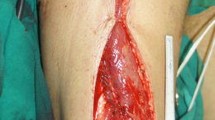Summary
A new wound dressing, chitin non-woven fabric was applied in 91 patients for dressing of donor sites, skin graft areas, raw areas under pedicle flaps and those associated with skin abrasion, as well as burns and skin ulcers. Chitin dressing showed excellent results with regard to satisfactory pain relief, adherence to the wound and drying without dissolution or other adverse effects.
Similar content being viewed by others
References
Ando M, Ando Y (1979) Study on preservation of human amniotic membrane. Jpn J Burn Inj 4:184–189
Balassa LL, Prudden JF (1977) Applications of chitin and chitosan in wound healing acceleration. Proc 1st Int Conference on Chitin/Chitosan, pp 296–305
Berger LR, Weiser RS (1957) The β-glucosaminidase activity of egg-white lysozyme. Biochem Biophys Acta 26:517–521
Frank DH, Wachtel T, Frank HA, Sanders R (1983) Comparison of Biobrane porcine skin and human allograft as biological dressings for burn wounds. JBCR 4:186–190
Golan J, Eldad A, Rudensky B, Tuchman Y (1985) A new temporary synthetic skin substitute. Burns 11:274–280
Hansbrough JF, Zapata-Sirvent R, Carroll WJ, Dominic WJ (1984) Clinical experience with Biobrane biosynthetic dressing in the treatment of partial thickness burns. Burns 10:415–419
Husain MT, Akhtar M, Akhtar N (1982) Report on evaluation of hydron film as burn wound dressing. Burns 9:330–334
Keswani MH, Patil AR (1985) The boiled potato peel as a burn wound dressing. Burns 11:220–224
KT-80 Research Group (1981) Clinical trials of lyophilized porcine dermis (KT-80). Jpn J Burn Inj 7:135–148
Maeda K (1975) An experimental and clinical study of collagen membrane as a biological dressing for burn wound and de-epithelialized area. Jpn J Burn Inj 4:158–162
Nishi S (1983) The clinical application of porcine fibrin film. Jpn J Burn Inj 9:87–97
Ohshima Y, Komai M, Miyamoto Y (1981) Use of lyophilized porcine skin for wound dressings. Med J Kyoto RCH 2:152–156
Ohshima Y, Nishino K, Yonekura Y, Maeda M (1986) The clinical application of chitin non-woven fabric in the topical treatment of burns. Jpn J Burn Inj 12:31–36
Prudden JF, Migel P, Hanson P, Friedrich L, Balassa LL (1977) The discovery of a potent pure chemical wound healing accelerator. Am J Surg 119:560–564
Tabies MJ, Thronton JW, Bartlett RH, Roth JC, Woodroof EA (1980) A new composite skin prosthesis. Burns 7:123–130
Umeda T, Honda K, Igawa H, Yoshida T, Ohura T (1983) The application of Biobrane, a new composite skin prosthesis. Jpn J Burn Inj 9:73–77
Author information
Authors and Affiliations
Rights and permissions
About this article
Cite this article
Ohshima, Y., Nishino, K., Yonekura, Y. et al. Clinical application of chitin non-woven fabric as wound dressing. Eur J Plast Surg 10, 66–69 (1987). https://doi.org/10.1007/BF00578375
Issue Date:
DOI: https://doi.org/10.1007/BF00578375




